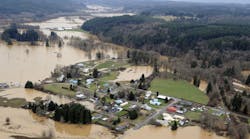
Welcome to the Winter 2022 issue of Stormwater magazine. Though there are few traditional signs of the season here in Southern California, this time of year is always a good one to take stock of where we are and where we are going. Where we are is entering year three of a global pandemic, whose ongoing influence on our everyday lives seems like it might never end. However, updates to CDC guidance and promising reports of the vaccine’s effectiveness against new variants means that where we are going looks better every day.
Indeed, stormwater’s time has come thanks to a spotlight placed on the industry and its projects with the passage of the 2021 Infrastructure Investment and Jobs Act. The $1 trillion bipartisan-backed bill includes new funding streams for the WIFIA program, State Revolving Fund programs, small and disadvantaged utilities, and national lead service line replacements.
Among the bill’s provisions are allocations for EPA’s Sewer Overflow and Stormwater Reuse Municipal Grants (OSG), funded at $280 million annually for 5 years; for a total of $1.4B overall. Of that funding, 25 percent is reserved for rural and financially distressed communities.
Further bolstering the industry is another key piece of legislation, the House-passed Build Back Better Act, which includes $1.85 billion for stormwater projects, of which $1.35 billion is reserved for financially distressed communities. The Stormwater Centers of Excellence, funded at $5 million annually for five years (amounting to $25 million in overall allocation) will continue to focus on identifying the best technologies and practices for green infrastructure, BMPs and overall stormwater management. These new funding streams represent the largest influx to the sector in 50 years.
The National Municipal Stormwater Alliance (NMSA) has kept track of several other bright lights for the industry. As a nonprofit, NMSA has made significant contributions to the stormwater/MS4 sector through policy leadership, state and regional engagement and support, technical information development and dissemination, and raising the awareness and profile of stormwater overall since its founding in 2018. This month, NMSA Executive Director Seth Brown outlines the top legislative and regulatory issues for the industry in the first of what will be a recurring column from the organization. Read more on page 26 and keep an eye out for the section in future issues of Stormwater.
Our cover story this month looks at how stormwater management can create more resilient communities as we face the effects of climate change. Read about how Kleinfelder worked closely with the City of Cambridge’s Department of Public Works to design a 390,000-gallon underground stormwater tank in one of the area’s oldest neighborhoods while navigating a complex underground utility landscape on page 10.
For project managers considering infiltration and subsurface evaluation for stormwater projects, our BMP Maintenance feature on page 14 covers all you need to know, from pre-planning to design and final evaluations. Building on that advice, on page 20, a case study involving stormwater regulatory compliance throughout the design and construction phase to ensure BMPs are followed; including aspects like site access, stored materials, and more will guide you through one author’s process.
Finally, as you plan the coming months, be sure to put StormCon 2022 on your calendars. The program’s Call for Abstracts is now open, and we are working diligently to put together the best lineup yet for this year’s conference. Join us in person September 26-28 in National Harbor, Md., where speakers from across the nation will present lessons learned, insights and case studies. In the exhibit hall, industry-leading companies will showcase top products and services. I hope to see you there! SW
Published in Stormwater magazine, February 2022.

